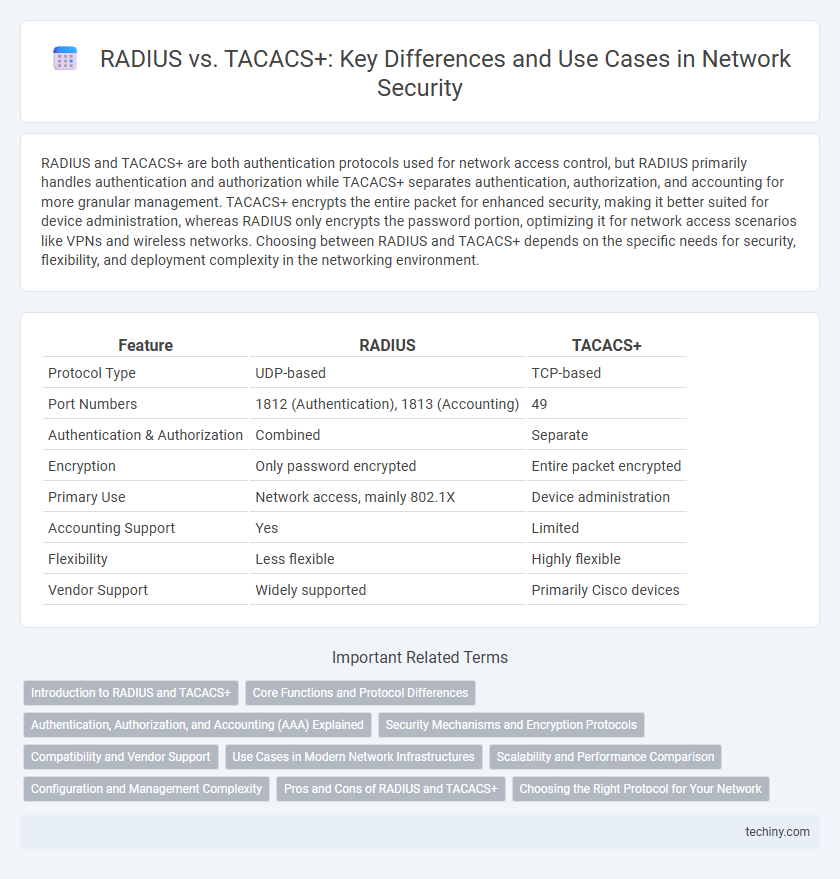RADIUS and TACACS+ are both authentication protocols used for network access control, but RADIUS primarily handles authentication and authorization while TACACS+ separates authentication, authorization, and accounting for more granular management. TACACS+ encrypts the entire packet for enhanced security, making it better suited for device administration, whereas RADIUS only encrypts the password portion, optimizing it for network access scenarios like VPNs and wireless networks. Choosing between RADIUS and TACACS+ depends on the specific needs for security, flexibility, and deployment complexity in the networking environment.
Table of Comparison
| Feature | RADIUS | TACACS+ |
|---|---|---|
| Protocol Type | UDP-based | TCP-based |
| Port Numbers | 1812 (Authentication), 1813 (Accounting) | 49 |
| Authentication & Authorization | Combined | Separate |
| Encryption | Only password encrypted | Entire packet encrypted |
| Primary Use | Network access, mainly 802.1X | Device administration |
| Accounting Support | Yes | Limited |
| Flexibility | Less flexible | Highly flexible |
| Vendor Support | Widely supported | Primarily Cisco devices |
Introduction to RADIUS and TACACS+
RADIUS (Remote Authentication Dial-In User Service) is a protocol primarily used for network authentication, authorization, and accounting, widely adopted in ISP and enterprise network environments. TACACS+ (Terminal Access Controller Access-Control System Plus) offers enhanced security by separating authentication, authorization, and accounting processes, making it ideal for device administration and network management. Both protocols support centralized access control but differ in encryption methods and flexibility, with TACACS+ providing more granular command-level authorization.
Core Functions and Protocol Differences
RADIUS primarily handles authentication, authorization, and accounting for network access via UDP, optimizing scalability for ISPs and wireless networks. TACACS+ uses TCP to separate these functions, providing enhanced security and granular control ideal for device administration in enterprise environments. The protocol distinction impacts performance, where RADIUS's simpler UDP design favors speed, while TACACS+ ensures reliable session management and encryption tailored to sensitive device access control.
Authentication, Authorization, and Accounting (AAA) Explained
RADIUS centralizes Authentication, Authorization, and Accounting by combining these functions in a single protocol primarily used for network access control, supporting UDP transport for faster communication. TACACS+ separates AAA functions for enhanced security and flexibility, using TCP to ensure reliable delivery and encrypting the entire payload for stronger protection in device administration. Both protocols are crucial for managing network security, with RADIUS favored for user access control and TACACS+ preferred in scenarios requiring granular command authorization and centralized device management.
Security Mechanisms and Encryption Protocols
RADIUS uses UDP and encrypts only the user's password in the access-request packet, leaving other attributes exposed, which limits its security effectiveness. TACACS+ operates over TCP and encrypts the entire packet, including authentication, authorization, and accounting data, providing a more robust security mechanism. The comprehensive encryption and TCP-based reliable transport make TACACS+ more suitable for environments requiring stringent access control and enhanced confidentiality.
Compatibility and Vendor Support
RADIUS offers broad compatibility and is widely supported across various network devices from multiple vendors, making it a preferred choice for diverse environments. TACACS+ provides better vendor-specific feature support, especially with Cisco products, due to its proprietary nature and granular control over authentication, authorization, and accounting. Organizations typically choose RADIUS for multi-vendor interoperability and TACACS+ for enhanced Cisco device management and security customization.
Use Cases in Modern Network Infrastructures
RADIUS excels in managing centralized authentication, authorization, and accounting for network access, particularly in Wi-Fi and VPN environments where user credentials require secure validation. TACACS+ is preferred for device administration in modern network infrastructures, offering granular command-level authorization and separate encryption for authentication and authorization data, enhancing control over network equipment. Enterprises often deploy RADIUS for user endpoint authentication while leveraging TACACS+ to secure and manage network devices, optimizing overall security and operational efficiency.
Scalability and Performance Comparison
RADIUS and TACACS+ differ significantly in scalability and performance, with RADIUS optimized for large-scale network access control owing to its lightweight protocol design and UDP transport, which enables faster authentication processes under high loads. TACACS+ uses TCP, providing more reliable and secure communication but introducing higher latency, making it less performant in extremely large deployments. Enterprises requiring rapid, scalable user authentication in distributed environments often prefer RADIUS, whereas TACACS+ suits organizations demanding detailed command-level authorization despite modest scalability constraints.
Configuration and Management Complexity
RADIUS offers simpler configuration with centralized authentication but limited command authorization and accounting features, making it suitable for basic network access control. TACACS+ provides granular command authorization and detailed accounting, enhancing management capabilities at the cost of increased configuration complexity. Network administrators prioritize TACACS+ for environments requiring precise control and auditing, while RADIUS is preferred for straightforward implementation and lower administrative overhead.
Pros and Cons of RADIUS and TACACS+
RADIUS offers centralized authentication that integrates well with network access servers and supports accounting features, but it uses UDP, which can be less reliable and provides coarse-grained authorization. TACACS+ employs TCP, ensuring reliable communication with separate authentication, authorization, and accounting processes, allowing finer control and stronger security, though it requires more configuration and is typically more complex to deploy. Both protocols serve different use cases: RADIUS is preferred for network access and ISP environments, while TACACS+ excels in device administration with granular privilege management.
Choosing the Right Protocol for Your Network
RADIUS excels in managing network access control with centralized authentication, authorization, and accounting, making it ideal for ISP and Wi-Fi environments. TACACS+ provides enhanced security with separate authentication, authorization, and accounting processes, offering granular control preferred in enterprise networks and device administration. Selecting the right protocol depends on your network's security requirements, scalability needs, and whether you prioritize unified access management or detailed command-level authorization.
RADIUS vs TACACS+ Infographic

 techiny.com
techiny.com